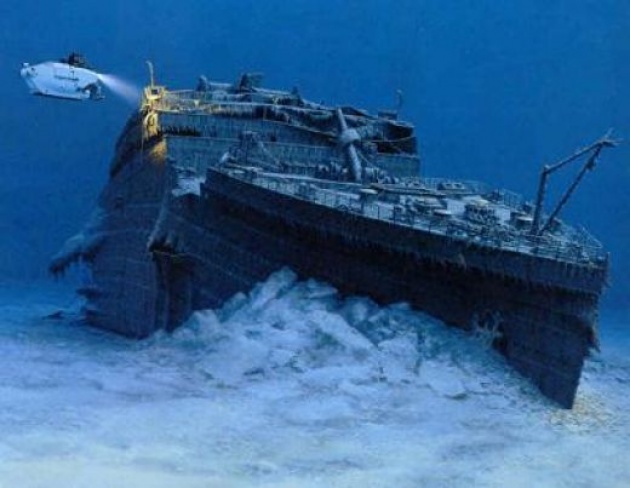
As a century passes since its sinking, the Titanic underwater wreck will now be protected by a United Nations Educational, Scientific and Cultural Organization (UNESCO) convention that seeks to safeguard wrecks, sites, decorated caves and other cultural relics underwater. Until now, the RMS Titanic was not eligible for protection under the UNESCO Convention on the Protection of Underwater Cultural Heritage, as the treaty only applies to remains submerged for at least 100 years. This year marks the 100th anniversary of the tragedy that occurred on the night of 14 April 1912, when the ship struck an iceberg in the North Atlantic and sank.
UNESCO’s Director-General, Irina Bokova offered in News Release contained in full below that: “The sinking of the Titanic is anchored in the memory of humanity and I am pleased that this site can now be protected by the UNESCO convention. But there are thousands of other shipwrecks that need safeguarding as well. All of them are archaeological sites of scientific and historical value. They are also the memory of human tragedy that should be treated with respect. We do not tolerate the plundering of cultural sites on land, and the same should be true for our sunken heritage.”
To date, 41 States have ratified the convention, which entered into force in 2009. Besides shipwrecks, the convention aims to protect such sunken historical sites as the ruins of the Alexandria lighthouse and Cleopatra’s palace in Egypt, part of ancient Carthage in Tunisia, and Jamaica’s Port Royal, destroyed by an earthquake in 1692, as well as entire landscapes and rock art caves now at the bottom of the sea.
Ambassador Muhamed Sacirbey - FOLOW mo @MuhamedSacirbey
Facebook-Become a Fan at “Diplomatically Incorrect”
Twitter – Follow us @DiplomaticallyX
See more at our Popular Video Blogs & Current News Event Articles on Diplomat-Artist Channels
UNESCO Statement:
On the night of April 14th 1912, the RMS Titanic struck an iceberg in the North Atlantic and sank. This year marks the 100th anniversary of the tragedy, which means that the wreck now comes under the cover of the 2001 UNESCO Convention on the Protection of Underwater Cultural Heritage. UNESCO Director-General Irina Bokova marked the occasion -by expressing concern about the destruction and looting of shipwrecks and underwater archaeological sites around the world.
The vestiges of the Titanic lie at a depth of 4,000 meters off the coast of Newfoundland. No single State can claim the site because the wreck is in international waters. States only have jurisdiction over wrecks lying in their own waters and flying their flag. Previously the Titanic was not eligible for protection under the UNESCO Convention, which only applies to remains submerged for at least 100 years.
From now on, States Parties to the Convention can outlaw the destruction, pillage, sale and dispersion of objects found at the site. They can take all possible measures within their power to protect the wreck and ensure that the human remains there are treated with dignity. The 2001 Convention provides for system of cooperation between States Parties, to prevent exploration deemed unscientific or unethical. They also have the authority to seize any illicitly recovered artefacts and close their ports to all vessels undertaking exploration that is not done according to the principles of the Convention.
The Director-General of UNESCO, Irina Bokova, expressed her satisfaction that the Titanic could now be properly safeguarded, but voiced concern over the damage and looting of the countless ancient shipwrecks that new technology has made accessible.
“The sinking of the Titanic is anchored in the memory of humanity and I am pleased that this site can now be protected by the UNESCO Convention. But there are thousands of other shipwrecks that need safeguarding as well. All of them are archaeological sites of scientific and historical value. They are also the memory of human tragedy that should be treated with respect. We do not tolerate the plundering of cultural sites on land, and the same should be true for our sunken heritage,” said the Director-General. She called on divers not to dump equipment or commemorative plaques on the Titanic site.
Adopted in 2001 by the General Conference of UNESCO, the Convention on the Protection of Underwater Cultural Heritage aims to ensure better protection of wrecks, sites, decorated caves and other cultural relics underwater. This international treaty is a response from the global community to the growing incidence of looting and destruction of submerged heritage sites by treasure hunters. Although principally designed to preserve sites in situ, the Convention also aims to promote public access to them and to encourage archaeological research. It doesn’t, however, intend to settle the question of ownership and does not undermine the sovereign rights of states. To date, 41 States have ratified the Convention for the Protection of Underwater Cultural Heritage, which entered into force January 2nd, 2009.



